Mineralogical and Chemical Tracing of Dust Variation in an Underground Historic Salt Mine
Abstract
:1. Introduction
2. Materials and Methods
2.1. Study Site
2.2. Geological Background
2.3. Ventilation System
2.4. Selection of the Sampling Sites
2.5. Sample Collection and Analytical Methods
2.6. Pollution Indices
3. Results
3.1. Mineral Composition and Distribution
3.2. Micromorphology of Particles
3.3. Elemental Composition and Distribution
3.3.1. Major Elements
3.3.2. Minor Elements
3.3.3. Trace Elements
3.4. Enrichment Factor
4. Discussion and Source Identification
4.1. Natural Components from Host Rock
4.1.1. Distribution of Minerals
4.1.2. Distribution of Elements
4.2. The Effect of Indoor Activities
4.3. The Effect of External Air Pollution
5. Conclusions and Implications for Management
- The mechanical ventilation necessary for proper ventilation of extensive underground networks causes various airborne components of external origin to entry with a sucked fresh air stream to the underground atmosphere. These are natural geogenic and biogenic dust components, anthropogenic air pollution in the form of particulate matter and gaseous pollution, and particles from the deterioration of the lining of the downcast shaft. However, as a result of instantaneous sedimentation resulting from gradients in moisture, temperature, and airflow speed, these components are largely deposited underground in the close vicinity of the air inlet to the mine. This makes the air inside the mine much cleaner than the ambient air on the surface. Such effective air purification processes taking place at the very beginning of the air entrance zone seem to confirm the high potential of respiratory rehabilitation conducted in this kind of subterranean facility.
- The primary mineral constituents of the particles settled in the mine interior are natural materials derived from the weathering of the host rock. The mineral components present in the aerosols of the mine interior were not influenced by the particles sucked into the mine by the ventilation system. Biogenic allergens are missing as well as regular dust primarily composed of quartz sand and soil particles. The mineral composition of the dust in the mine interior is dominated by mineral components of local rocks: halite, anhydrite, and claystone. Their amount is small. Their properties, size, and morphology pose no risk to human health. The elemental composition and distribution of the elements in most of the samples taken along the airflow in the mine interior primarily correspond to geogenic sources. Additionally, the deposited dust in the mine interior contained anthropogenic particles of local origin (fragments of hair, clothing, skin, etc.) typical of indoor air pollution in public utility environments.
- The tourist railroad and the associated tourist traffic are a local source of atmospheric dust components, which differ in their mineral and chemical composition from dusts found in other parts of the mine museum. This is because in the subway, various processes associated with the operation (wear and friction of the rails, wheels, and brakes and increased passenger traffic) are responsible for these emissions. The gravitational deposition of these pollutants causes rapid self-cleaning of the air and limits the effects of the emissions at the local range. On the other hand, deposition of these rust-colored contaminants on the surfaces of mine walls and museum artifacts (e.g., sculptures carved into salt rock) can adversely affect their natural and aesthetic values. Due to the relatively short exposure of visitors to this type of local contamination, there is no risk to people visiting the museum. However, rest or rehabilitation areas should be arranged in the mine at some distance from such attractions.
Supplementary Materials
Author Contributions
Funding
Data Availability Statement
Acknowledgments
Conflicts of Interest
References
- Kara, M.; Dumanoglu, Y.; Altiok, H.; Elbir, T.; Odabasi, M.; Bayram, A. Seasonal and spatial variations of atmospheric trace elemental deposition in the Aliaga industrial region, Turkey. Atmos. Res. 2014, 149, 204–216. [Google Scholar] [CrossRef]
- Wawer, M.; Magiera, T.; Jabłońska, M.; Kowalska, J.; Rachwał, M. Geochemical characteristics of solid particles deposited on experimental plots established for traffic pollution monitoring in different countries. Chemosphere 2020, 260, 127575. [Google Scholar] [CrossRef] [PubMed]
- Brimblecombe, P.; Thickett, D.; Yoon, Y.H. The cementation of coarse dust to indoor surfaces. J. Cult. Heritage 2009, 10, 410–414. [Google Scholar] [CrossRef]
- Marcotte, S.; Estel, L.; Minchin, S.; Leboucher, S.; Le Meur, S. Monitoring of lead, arsenic and mercury in the indoor air and settled dust in the Natural History Museum of Rouen (France). Atmos. Pollut. Res. 2017, 8, 483–489. [Google Scholar] [CrossRef]
- Uring, P.; Chabas, A.; Alfaro, S. Dust deposition on textile and its evolution in indoor cultural heritage. Eur. Phys. J. Plus 2019, 134, 255. [Google Scholar] [CrossRef]
- Shi, T.; Wang, Y. Heavy metals in indoor dust: Spatial distribution, influencing factors, and potential health risks. Sci. Total Environ. 2021, 755, 142367. [Google Scholar] [CrossRef]
- Pérez-Álvarez, R.; Torres-Ortega, S.; Díaz-Simal, P.; Husillos-Rodríguez, R.; De Luis-Ruiz, J.M. Economic Valuation of Mining Heritage from a Recreational Approach: Application to the Case of El Soplao Cave in Spain (Geosite UR004). Sustainability 2016, 8, 185. [Google Scholar] [CrossRef] [Green Version]
- Caamaño-Franco, I.; Suárez, M.A. The Value Assessment and Planning of Industrial Mining Heritage as a Tourism Attraction: The Case of Las Médulas Cultural Space. Land 2020, 9, 404. [Google Scholar] [CrossRef]
- Saiz-Jimenez, C.; Cuezva, S.; Jurado, V.; Fernandez-Cortes, A.; Porca, E.; Benavente, D.; Cañaveras, J.C.; Sanchez-Moral, S. Paleolithic art in peril: Policy and science collide at Altamira Cave. Science 2011, 334, 42–43. [Google Scholar] [CrossRef] [Green Version]
- Telbisz, T.; Gruber, P.; Mari, L.; Kőszegi, M.; Bottlik, Z.; Standovár, T. Geological heritage, geotourism and local development in Aggtelek National Park (NE Hungary). Geoheritage 2020, 12, 5. [Google Scholar] [CrossRef] [Green Version]
- Festi, D.; Brandner, D.; Grabner, M.; Knierzinger, W.; Reschreiter, H.; Kowarik, K. 3500 years of environmental sustainability in the large-scale alpine mining district of Hallstatt, Austria. J. Archaeolog. Sci. Rep. 2021, 35, 102768. [Google Scholar] [CrossRef]
- Voudouris, P.; Melfos, V.; Mavrogonatos, C.; Photiades, A.; Moraiti, E.; Rieck, B.; Kolitsch, U.; Tarantola, A.; Scheffer, C.; Morin, D.; et al. The Lavrion Mines: A Unique Site of Geological and Mineralogical Heritage. Minerals 2021, 11, 76. [Google Scholar] [CrossRef]
- Puławska, A.; Manecki, M.; Flasza, M.; Waluś, E.; Wojtowicz, K. Rare Occurrence of Mirabilite in the Thirteenth-Century Historic Salt Mine in Bochnia (Poland): Characterisation, Preservation, and Geotourism. Geoheritage 2021, 13, 36. [Google Scholar] [CrossRef]
- Trofimova, E.; Trofimov, A. World Subterranean Heritage. Geoheritage 2019, 11, 1113–1131. [Google Scholar] [CrossRef]
- Madziarz, M. Historical ore mining sites in Lower Silesia (Poland) as geo-tourism attraction. Acta Geoturistica 2013, 4, 15–26. [Google Scholar]
- Marescotti, P.; Brancucci, G.; Sasso, G.; Solimano, M.; Marin, V.; Muzio, C.; Salmona, P. Geoheritage Values and Environmental Issues of Derelict Mines: Examples from the Sulfide Mines of Gromolo and Petronio Valleys (Eastern Liguria, Italy). Minerals 2018, 8, 229. [Google Scholar] [CrossRef] [Green Version]
- Costa, E.; Dino, G.A.; Benna, P.; Benna, P.; Rossetti, P. The Traversella Mining Site as Piemonte Geosite. Geoheritage 2019, 11, 55–70. [Google Scholar] [CrossRef]
- Kazancı, N.; Suludere, Y.; Özgüneylioğlu, A.; Mülazımoğlu, N.S.; Şaroğlu, F.; Mengi, H.; Boyraz-Aslan, S.; Gürbüz, E.; Yücel, T.O.; Ersöz, M.; et al. Mining Heritage and Relevant Geosites as Possible Instruments for Sustainable Development of Miner Towns in Turkey. Geoheritage 2019, 11, 1267–1276. [Google Scholar] [CrossRef]
- Carrión-Mero, P.; Loor-Oporto, O.; Andrade-Ríos, H.; Herrera-Franco, G.; Morante-Carballo, F.; Jaya-Montalvo, M.; Aguilar-Aguilar, M.; Torres-Peña, K.; Berrezueta, E. Quantitative and Qualitative Assessment of the “El Sexmo” Tourist Gold Mine (Zaruma, Ecuador) as A Geosite and Mining Site. Resources 2020, 9, 28. [Google Scholar] [CrossRef] [Green Version]
- Freidl, J.; Huber, D.; Braunschmid, H.; Romodow, C.; Pichler, C.; Weisböck-Erdheim, R.; Mayr, M.; Hartl, A. Winter Exercise and Speleotherapy for Allergy and Asthma: A Randomized Controlled Clinical Trial. J. Clin. Med. 2020, 9, 3311. [Google Scholar] [CrossRef] [PubMed]
- Kostrzon, M.; Sliwka, A.; Wloch, T.; Szpunar, M.; Ankowska, D.; Nowobilski, R. Subterranean Pulmonary Rehabilitation in Chronic Obstructive Pulmonary Disease. In Advances in Biomedicine. Advances in Experimental Medicine and Biology; Springer: Cham, Switzerland, 2019; Volume 1176, pp. 35–46. [Google Scholar] [CrossRef]
- Puławska, A.; Manecki, M.; Flasza, M.; Styszko, K. Origin, distribution, and perspective health benefits of particulate matter in the air of underground salt mine: A case study from Bochnia, Poland. Environ. Geochem. Health 2021, 1–24. [Google Scholar] [CrossRef]
- Lang, M.; Faimon, J.; Pracný, P.; Kejíková, S. A show cave management: Anthropogenic CO2 in atmosphere of Výpustek Cave (Moravian Karst, Czech Republic). J. Nat. Conserv. 2017, 35, 40–52. [Google Scholar] [CrossRef]
- Liñán, C.; del Rosal, Y.; Carrasco, F.; Vadillo, I.; Benavente, J.; Ojeda, L. Highlighting the importance of transitional ventilation regimes in the management of Mediterranean show caves (Nerja-Pintada system, southern Spain). Sci. Total Environ. 2018, 631, 1268–1278. [Google Scholar] [CrossRef] [PubMed]
- Myszkowska, D.; Kostrzon, M.; Dyga, W.; Kędzierska, J.; Namysł, M.; Stanisz, A.; Zagórska, M.; Ziemianin, M.; Obtułowicz, K.; Czarnobilska, E. Bioaerosol of salt chambers in the ‘Wieliczka’ Salt Mine, Poland. Aerobiologia 2019, 35, 297–311. [Google Scholar] [CrossRef] [Green Version]
- Górny, R.L.; Frączek, K.; Ropek, D.R. Size distribution of microbial aerosols in overground and subterranean treatment chambers at health resorts. J. Environ. Health. Sci. Engineer. 2020, 18, 1437–1450. [Google Scholar] [CrossRef]
- Mulec, J.; Oarga-Mulec, A.; Šturm, S.; Tomazin, R.; Matos, T. Spacio-Temporal Distribution and Tourist Impact on Airborne Bacteria in a Cave (Škocjan Caves, Slovenia). Diversity 2017, 9, 28. [Google Scholar] [CrossRef] [Green Version]
- Wlazło, Ł.; Kasela, M.; Nowakowicz-Dębek, B.; Ossowski, M.; Malm, A. Bioaerosols in an Underground Tourist Trail. Pol. J. Environ. Stud. 2020, 29, 3865–3872. [Google Scholar] [CrossRef]
- Grgić, I.; Iskra, I.; Podkrajšek, B.; & Gerjevič, V.B. Measurements of aerosol particles in the Škocjan Caves, Slovenia. Environ. Sci. Pollut. R. 2014, 21, 1915–1923. [Google Scholar] [CrossRef]
- Smith, A.C.; Wynn, P.M.; Barker, P.A. Natural and anthropogenic factors which influence aerosol distribution in Ingleborough Show Cave, UK. Int. J. Speleol. 2012, 42, 49–56. [Google Scholar] [CrossRef] [Green Version]
- Tanda, S.; Licbinsky, R.; Hegrova, J.; Faimon, J.; Goessler, W. Arsenic speciation in aerosols of a respiratory therapeutic cave: A first approach to study arsenicals in ultrafine particles. Sci. Total Environ. 2019, 651, 1839–1848. [Google Scholar] [CrossRef] [PubMed]
- Ličbinský, R.; Faimon, J.; Tanda, S.; Hegrova, J.; Goessler, W.; Uberhuberova, J. Changes in the elemental composition of particulate matter in a speleotherapeutic cave. Atmos. Pollut. Res. 2020, 11, 1142–1154. [Google Scholar] [CrossRef]
- Salmon, L.G.; Christoforou, C.S.; Gerk, T.J.; Cass, G.R.; Cassucio, G.S.; Cooke, G.A.; Leger, M.; Olmez, I. Source contributions to airborne particle deposition at the Yungang Grottoes, China. Sci. Total Environ. 1995, 167, 33–47. [Google Scholar] [CrossRef]
- Muri, G.; Jovičić, A.; Mihevc, A. Source assessment of deposited particles in a Slovenian show cave (Postojnska jama): Evidence of long-lasting anthropogenic impact. Int. J. Speleol. 2013, 42, 225–233. [Google Scholar] [CrossRef] [Green Version]
- Trechera, P.; Moreno, T.; Córdoba, P.; Moreno, N.; Zhuang, X.; Li, B.; Li, J.; Shangguan, Y.; Kandler, K.; Dominguez, A.O.; et al. Mineralogy, geochemistry and toxicity of size-segregated respirable deposited dust in underground coal mines. J. Hazard. Mater. 2020, 399, 122935. [Google Scholar] [CrossRef] [PubMed]
- Mulec, J. Human impact on underground cultural and natural heritage sites, biological parameters of monitoring and remediation actions for insensitive surfaces: Case of Slovenian show caves. J. Nat. Conserv. 2014, 22, 132–141. [Google Scholar] [CrossRef]
- Ravbar, N.; Šebela, S. The effectiveness of protection policies and legislative framework with special regard to karst landscapes: Insights from Slovenia. Environ. Sci. Policy 2015, 51, 106–116. [Google Scholar] [CrossRef]
- Tičar, J.; Tomić, N.; Berg Valjavec, M.; Zorn, M.; Marković, S.B.; Gavrilov, M.B. Speleotourism in Slovenia: Balancing between mass tourism and geoheritage protection. Open Geosci. 2018, 10, 344–357. [Google Scholar] [CrossRef]
- Brandi, I.; Barbosa, M.; Guimarães de Paula, R.; Araújo, R.; Vieira de Moura, R.; Mota de Lima, H. Instrumented geotechnical monitoring of a natural cave in a near mine operation—Towards a sustainable approach to mining and preservation of speleological heritage. J. Clean. Prod. 2019, 239, 118040. [Google Scholar] [CrossRef]
- Liu, J.F.; Ma, T.F.; Liu, Y.L.; Zou, J.; Gao, M.Z.; Zhang, R.; Wu, J.; Liu, S.X.; Xie, H.P. History, advancements, and perspective of biological research in deep-underground laboratories: A brief review. Environ. Int. 2018, 120, 207–214. [Google Scholar] [CrossRef]
- Xie, H.; Zhao, J.W.; Zhou, H.W.; Ren, S.H.; Zhang, R.X. Secondary utilizations and perspectives of mined underground space. Tunn. Undergr. Space Technol. 2020, 96, 103129. [Google Scholar] [CrossRef]
- Salmon, L.G.; Cass, G.R.; Kozłowski, R.; Hejda, A.; Spiker, E.C.; Bates, A.L. Air Pollutant Intrusion into the Wieliczka Salt Mine. Environ. Sci. Technol. 1996, 30, 872–880. [Google Scholar] [CrossRef]
- Wiewiórka, J.; Dudek, K.; Charkot, J.; Gonera, M. Natural and historic heritage of the Bochnia salt mine (South Poland). Studia UBB Geol. 2009, 54, 43–47. [Google Scholar] [CrossRef] [Green Version]
- Peryt, D.; Gedl, P.; Peryt, T.M. Marine transgression(s) to evaporite basin: The case of middle Miocene (Badenian) gypsum in the Central Paratethys, SE Poland. J. Palaeogeogr. 2020, 9, 16. [Google Scholar] [CrossRef]
- Garlicki, A. Salt Mines at Bochnia and Wieliczka. Przegląd Geol. 2008, 56, 663–669. [Google Scholar]
- Poborski, J. The Bochnia salt deposit on the geological background of region. Biul. Państwowego Inst. Geol. 1952, 78, 3–160, (In Polish with English Summary). [Google Scholar]
- Garlicki, A. Sedimentation of Miocene Salts in Poland. Pr. Geol. PAN 1979, 119, 1–67, (In Polish with English Summary). [Google Scholar]
- Burliga, S.; Krzywiec, P.; Dąbroś, K.; Przybyło, J.; Włodarczyk, E.; Źróbek, M.; Słotwiński, M. Salt tectonics in front of the Outer Carpathian thrust wedge in the Wieliczka area (S Poland) and its exposure in the underground salt mine. Geol. Geophys. Environ. 2018, 44, 71–90. [Google Scholar] [CrossRef] [Green Version]
- Marciniak, H.; Diduszko, R.; Kozak, M. XRAYAN—Program. Do Rentgenowskiej Analizy Fazowej; KOMA: Warszawa, Poland, 2006. (In Polish) [Google Scholar]
- Loska, K.; Wiechula, D.; Korus, I. Metal contamination of farming soils affected by industry. Environ. Int. 2004, 30, 159–165. [Google Scholar] [CrossRef]
- Peña-Icart, M.; Pereira-Filho, E.R.; Lopes Fialho, L.; Nóbrega, J.A.; Alonso-Hernández, C.; Bolaños-Alvarez, Y.; Pomares-Alfonso, M.S. Combining contamination indexes, sediment quality guidelines and multivariate data analysis for metal pollution assessment in marine sediments of Cienfuegos Bay, Cuba. Chemosphere 2017, 168, 1267–1276. [Google Scholar] [CrossRef] [PubMed]
- Xu, F.J.; Hu, B.; Dou, Y.G.; Song, Z.J.; Liu, X.T.; Yuan, S.Q.; Sun, Z.L.; Li, A.C.; Yin, X.B. Prehistoric heavy metal pollution on the continental shelf off Hainan Island, South China Sea: From natural to anthropogenic impacts around 4.0 kyr BP. Holocene 2018, 28, 455–463. [Google Scholar] [CrossRef]
- Liu, J.; Yin, P.; Chen, X.; Cao, K. Distribution, Enrichment and Transport of Trace Metals in Sediments from the Dagu River Estuary in the Jiaozhou Bay, Qingdao, China. Minerals 2019, 9, 545. [Google Scholar] [CrossRef] [Green Version]
- Turekian, K.; Wedepohl, K. Distribution of the elements in some major units of the Earths crust. Geol. Soc. Am. Bull. 1961, 72, 175–192. [Google Scholar] [CrossRef]
- Kowalska, J.; Mazurek, R.; Gąsiorek, M.; Zaleski, T. Pollution indices as useful tools for the comprehensive evaluation of the degree of soil contamination—A review. Environ. Geochem. Health 2018, 40, 2395–2420. [Google Scholar] [CrossRef] [PubMed] [Green Version]
- Sutherland, R.A. Bed sediment-associated trace metals in an urban stream, Oahu, Hawaii. Environ. Geol. 2000, 39, 611–627. [Google Scholar] [CrossRef]
- Zhang, J.; Liu, C. Riverine Composition and Estuarine Geochemistry of Particulate Metals in China—Weathering Features, Anthropogenic Impact and Chemical Fluxes. Estuarine Coast. Shelf Sci. 2002, 54, 1051–1070. [Google Scholar] [CrossRef]
- Warren, J.K. Evaporites through time: Tectonic, climatic and eustatic controls in marine and nonmarine deposits. Earth-Sci. Rev. 2010, 98, 217–268. [Google Scholar] [CrossRef]
- Bąbel, M.; Schreiber, B.C. Geochemistry of evaporites and evolution of seawater. In Treatise on Geochemistry, 2nd ed.; Holland, H.D., Turekian, K.K., Eds.; Elsevier: Amsterdam, The Netherlands, 2014; pp. 483–560. [Google Scholar] [CrossRef]
- Kasprzyk, A. Sedimentological and diagenetic patterns of anhydrite deposits in the Badenian evaporite basin of the Carpathian Foredeep, southern Poland. Sediment. Geol. 2003, 158, 167–194. [Google Scholar] [CrossRef]
- Jarzyna, A.; Bąbel, M.; Ługowski, D.; Vladi, F.; Yatsyshyn, A.; Olszewska-Nejbert, D.; Nejbert, K.; Bogucki, A. Unique Hydration Caves and Recommended Photogrammetric Methods for Their Documentation. Geoheritage 2020, 12, 27. [Google Scholar] [CrossRef] [Green Version]
- Dredge, J.; Fairchild, I.J.; Harrison, R.M.; Fernandez-Cortes, A.; Sanchez-Moral, S.; Jurado, V.; Gunn, J.; Smith, A.; Spotl, C.; Mattey, D.; et al. Cave aerosols: Distribution and contribution to speleothem geochemistry. Quat. Sci. Rev. 2013, 63, 23–41. [Google Scholar] [CrossRef] [Green Version]
- Forti, P. Chemical deposits in evaporite caves: An overview. Int. J. Speleol. 2017, 46, 109–135. [Google Scholar] [CrossRef] [Green Version]
- Filippi, M.; Bruthans, J.; Palatinus, L.; Zare, M.; Asadi, N. Secondary halite deposits in the Iranian salt karst: General description and origin. Int. J. Speleol. 2011, 40, 141–162. [Google Scholar] [CrossRef]
- Sawłowicz, Z.; Przybyło, J.; Boroń, K. Colourful speleothems in the Wieliczka Salt Mine. Geol. Quart. 2014, 58, 449–458. [Google Scholar] [CrossRef] [Green Version]
- Środoń, J. Mixed-layer illite-smectite in low-temperature diagenesis: Data from the Miocene of the Carpathian Foredeep. Clay Miner. 1984, 19, 205–215. [Google Scholar] [CrossRef]
- Jasionowski, M.; Peryt, T.M. Isotopic composition of dolomite associated with Middle Miocene Badenian anhydrites in the Carpathian Foredeep Basin of SE Poland. Geol. Quart. 2010, 54, 533–548. [Google Scholar]
- Yaremchuk, Y.; Hryniv, S.; Peryt, T.; Vovnyuk, S.; Meng, F. Controls on Associations of Clay Minerals in Phanerozoic Evaporite Formations: An Overview. Minerals 2020, 10, 974. [Google Scholar] [CrossRef]
- Toboła, T. Study of potassium and magnesium contents in salt deposit Bochnia (Southern Poland). Przegląd Geol. 2000, 48, 688–693. [Google Scholar]
- Taitel-Goldman, N.; Ezersky, V.; Mogilyanski, D. High-resolution transmission electron microscopy study of Fe-Mn oxides in the hydrothermal sediments of the Red Sea deeps system. Clays Clay Miner. 2009, 57, 465–475. [Google Scholar] [CrossRef]
- Engelbrecht, J.P.; Moosmüller, H.; Pincock, S.; Jayanty, R.K.M.; Lersch, T.; Casuccio, G. Mineralogical, chemical, morphological, and optical. Atmos. Chem. Phys. 2016, 16, 10809–10830. [Google Scholar] [CrossRef] [Green Version]
- Leslie, A.B.; Harwood, G.M.; Kendall, A.C. Geochemical variations within a laminated evaporite deposit: Evidence for brine composition during formation of the Permian Castile Formation, Texas and New Mexico, USA. Sediment. Geol. 1997, 110, 223–235. [Google Scholar] [CrossRef]
- Karavoltsos, S.; Sakellari, A.; Bakeas, E.; Bekiaris, G.; Plavšić, M.; Proestos, C.; Zinelis, S.; Koukoulakis, K.; Diakos, I.; Dassenakis, M.; et al. Trace elements, polycyclic aromatic hydrocarbons, mineral composition, and FT-IR characterization of unrefined sea and rock salts: Environmental interactions. Environ. Sci. Pollut. Res. 2020, 27, 10857–10868. [Google Scholar] [CrossRef]
- Bukowski, K.; Galamay, A.; Krzywiec, P.; Maksym, A. Geochemical Data and Fluid Inclusion Study of the Middle Miocene Halite from Deep Borehole Huwniki-1, Situated in the Inner Zone of the Carpathian Foredeep in Poland. Minerals 2020, 10, 1113. [Google Scholar] [CrossRef]
- Toboła, T.; Kukiałka, P. The Lotsberg Salt Formation in Central Alberta (Canada)—Petrology, Geochemistry, and Fluid Inclusions. Minerals 2020, 10, 868. [Google Scholar] [CrossRef]
- Chen, Y.-M.; Gao, J.-B.; Yuan, Y.-Q.; Ma, J.; Yu, S. Relationship between heavy metal contents and clay mineral properties in surface sediments: Implications for metal pollution assessment. Cont. Shelf Res. 2016, 124, 125–133. [Google Scholar] [CrossRef]
- Moreno, T.; Trechera, P.; Querol, X.; Lah, R.; Johnson, D.; Wrana, A.; Williamson, B. Trace element fractionation between PM10 and PM2.5 in coal mine dust: Implications for occupational respiratory health. Int. J. Coal Geol. 2019, 203, 52–59. [Google Scholar] [CrossRef]
- Hryniv, S.M.; Peryt, T. Strontium distribution and celestite occurrence in Zechstein (Upper Permian) anhydrites Of West Poland. Geochemistry 2010, 70, 137–147. [Google Scholar] [CrossRef]
- Du Preez, G.; Wepener, V.; Dennis, I. Metal enrichment and contamination in a karst cave associated with anthropogenic activities in the Witwatersrand Basin, South Africa. Environ. Earth Sci. 2016, 75, 1–13. [Google Scholar] [CrossRef]
- Zgłobicki, W.; Telecka, M.; Skupiński, S. Heavy metals in playgrounds in Lublin (E Poland): Sources, pollution levels and health risk. Environ. Sci. Pollut. Res. 2020, 28, 18328–18341. [Google Scholar] [CrossRef] [PubMed]
- Dytłow, S.; Górka-Kostrubiec, B. Concentration of heavy metals in street dust: An implication of using different geochemical background data in estimating the level of heavy metal pollution. Environ. Geochem. Health 2021, 43, 521–535. [Google Scholar] [CrossRef] [PubMed]
- Querol, X.; Moreno, T.; Karanasiou, A.; Reche, C.; Alastuey, A.; Viana, M.; Font, O.; Gil, J.; De Miguel, E.; Capdevila, M. Variability of levels and composition of PM10 and PM2.5 in the Barcelona metro system. Atmos. Chem. Phys. 2012, 12, 5055–5076. [Google Scholar] [CrossRef] [Green Version]
- Moreno, T.; Martins, V.; Querol, X.; Jones, T.; BéruBé, K.; Minguillón, M.C.; Amato, F.; Capdevila, M.; de Miguel, E.; Centelles, S.; et al. A new look at inhalable metalliferous airborne particles on rail subway platforms. Sci. Total Environ. 2015, 505, 367–375. [Google Scholar] [CrossRef] [Green Version]
- Moreno, T.; Querol, X.; Martins, V.; Minguillón, M.C.; Reche, C.; Ku, L.H.; Eun, H.R.; Ahn, K.H.; Capdevila, M.; de Miguel, E. Formation and alteration of airborne particles in the subway environment. Environ. Sci. Process. Impacts 2017, 19, 59–64. [Google Scholar] [CrossRef]
- Lee, Y.; Lee, Y.-C.; Kim, T.; Choi, J.S.; Park, D. Sources and Characteristics of Particulate Matter in Subway Tunnels in Seoul, Korea. Int. J. Environ. Res. Public Health 2018, 15, 2534. [Google Scholar] [CrossRef] [PubMed] [Green Version]
- Isozaki, H.; Oosawa, J.; Kawano, Y.; Hirasawa, R.; Kubota, S.; Konishi, S. Measures against electrolytic rail corrosion in Tokyo Metro Subway Tunnels. Procedia Eng. 2016, 165, 583–592. [Google Scholar] [CrossRef]
- Sawłowicz, Z.; Malinowski, Ł.; Giże, A.; Stanek, J.; Przybyło, J. Mineralogical-Geochemical Study of Corroded Iron-Based Metals from a Salt Mine Environment. Corrosion 2020, 76, 666–677. [Google Scholar] [CrossRef]
- Adamiec, E.; Jarosz-Krzemińska, E.; Wieszała, R. Heavy metals from non-exhaust vehicle emissions in urban and motorway road dusts. Environ. Monit. Assess. 2016, 188, 369. [Google Scholar] [CrossRef] [Green Version]
- Minguillon, M.C.; Reche, C.; Martins, V.; Amato, F.; de Miguel, E.; Capdevila, M.; Centelles, S.; Querol, X.; Moreno, T. Aerosol sources in subway environments. Environ. Res. 2018, 167, 314–328. [Google Scholar] [CrossRef] [PubMed]
- Martínez-Guijarro, R.; Paches, M.; Romero, I.; Aguado, D. Enrichment and contamination level of trace metals in the Mediterranean marine sediments of Spain. Sci. Total Environ. 2019, 693, 133566. [Google Scholar] [CrossRef]
- Šebela, S.; Baker, G.; Luke, B. Cave Temperature and Management Implications in Lehman Caves, Great Basin National Park, USA. Geoheritage 2019, 11, 1163–1175. [Google Scholar] [CrossRef] [Green Version]
- Badyda, A.J.; Grellier, J.; Dąbrowiecki, P. Ambient PM2.5 Exposure and Mortality Due to Lung Cancer and Cardiopulmonary Diseases in Polish Cities. In Respiratory Treatment and Prevention. Advances in Experimental Medicine and Biology; Pokorski, M., Ed.; Springer: Cham, Switzerland, 2016; Volume 944. [Google Scholar] [CrossRef]
- Wilczyńska-Michalik, W.; Wilczyński, M. Air pollution in Cracow—A glance into the future from a historical perspective. Geobalcanica 2017, 3, 79–82. [Google Scholar] [CrossRef]
- Traczyk, P.; Gruszecka-Kosowska, A. The Condition of Air Pollution in Kraków, Poland, in 2005–2020, with Health Risk Assessment. Int. J. Environ. Res. Public Health 2020, 17, 6063. [Google Scholar] [CrossRef]
- Kaczmarczyk, M.; Sowiżdżał, A.; Tomaszewska, B. Energetic and Environmental Aspects of Individual Heat Generation for Sustainable Development at a Local Scale—A Case Study from Poland. Energies 2020, 13, 454. [Google Scholar] [CrossRef] [Green Version]
- Marszałek, M.; Alexandrowicz, Z.; Rzepa, G. Composition of weathering crusts on sandstones from natural outcrops and architectonic elements in an urban environment. Environ. Sci. Pollut. Res. 2014, 21, 14023–14036. [Google Scholar] [CrossRef] [PubMed] [Green Version]
- Lopez-Arce, P.; Garcia-Guinea, J. Weathering traces in ancient bricks from historic buildings. Build. Environ. 2005, 40, 929–941. [Google Scholar] [CrossRef] [Green Version]
- Yang, W.; Marshall, A.M.; Wanatowski, D.; Stace, L.R. An Experimental Evaluation of the Weathering Effects on Mine Shaft Lining Materials. Adv. Mater. Sci. Eng. 2017, 2017, 4219025. [Google Scholar] [CrossRef] [Green Version]
- Marszałek, M.; Dudek, K.; Gaweł, A. Cement Render and Mortar and Their Damages Due to Salt Crystallization in the Holy Trinity Church, Dominicans Monastery in Cracow, Poland. Minerals 2020, 10, 641. [Google Scholar] [CrossRef]
- Benavente, D.; de Jongh, M.; Cañaveras, J.C. Weathering Processes and Mechanisms Caused by Capillary Waters and Pigeon Droppings on Porous Limestones. Minerals 2021, 11, 18. [Google Scholar] [CrossRef]
- Cultrone, G.; De la Torre, M.J.; Sebastian, E.M.; Cazalla, O.; Rodriguez-Navarro, C. Behavior of Brick Samples in Aggressive Environments. Water Air Soil Poll. 2000, 119, 191–207. [Google Scholar] [CrossRef]
- Cultrone, G.; Arizzi, A.; Sebastián, E.; Rodríguez-Navarro, C. Sulfation of calcitic and dolomitic lime mortars in the presence of diesel particulate matter. Environ. Geol. 2008, 56, 741–752. [Google Scholar] [CrossRef]
- Morillas, H.; Maguregui, M.; Gallego-Cartagena, E.; Marcaida, I.; Carral, N.; Madariaga, J.M. The influence of marine environment on the conservation state of Built Heritage: An overview study. Sci. Total Environ. 2020, 745, 140899. [Google Scholar] [CrossRef]
- Vidal, F.; Vicente, R.; Mendes Silva, J. Review of environmental and air pollution impacts on built heritage: 10 questions on corrosion and soiling effects for urban intervention. J. Cult. Herit. 2019, 37, 273–295. [Google Scholar] [CrossRef]
- Alexandrowicz, Z.; Marszałek, M. Efflorescences on weathered sandstone tors in the Stone Town Nature Reserve in Ciężkowice the Outer Carpathians, Poland-their geochemical and geomorphological controls. Environ. Sci. Poll. Res. 2019, 26, 37254–37274. [Google Scholar] [CrossRef] [PubMed]
- Lewandowska, A.; Falkowska, L. Sea salt in aerosols over the Southern Baltic. Part 2. The neutralizing properties of sea salt and ammonia. Oceanologia 2013, 55, 299–318. [Google Scholar] [CrossRef] [Green Version]
- Adachi, K.; Buseck, P.R. Changes in shape and composition of sea-salt particles upon aging in an urban atmosphere. Atmos. Environ. 2015, 100, 1–9. [Google Scholar] [CrossRef]
- Perez, N.; Pey, J.; Reche, C.; Cortes, J.; Alastuey, A.; Querol, X. Impact of harbour emissions on ambient PM10 and PM2.5 in Barcelona (Spain): Evidences of secondary aerosol formation within the urban area. Sci. Total Environ. 2016, 571, 237–250. [Google Scholar] [CrossRef]
- AzadiAghdam, M.; Braun, R.A.; Edwards, E.-L.; Bañaga, P.A.; Cruz, M.T.; Betito, G.; Cambaliza, M.O.; Dadashazar, H.; Lorenzo, G.R.; Ma, L.; et al. On the nature of sea salt aerosol at a coastal megacity: Insights from Manila, Philippines in Southeast Asia. Atmos. Environ. 2019, 216, 116922. [Google Scholar] [CrossRef]
- Corral, A.F.; Dadashazar, H.; Stahl, C.; Edwards, E.-L.; Zuidema, P.; Sorooshian, A. Source Apportionment of Aerosol at a Coastal Site and Relationships with Precipitation Chemistry: A Case Study over the Southeast United States. Atmosphere 2020, 11, 1212. [Google Scholar] [CrossRef]
- Wu, S.P.; Dai, L.H.; Zhu, H.; Zhang, N.; Yan, J.P.; Schwab, J.J.; Yuan, C.S. The impact of sea-salt aerosols on particulate inorganic nitrogen deposition in the western Taiwan Strait region, China. Atmos. Res. 2019, 228, 68–76. [Google Scholar] [CrossRef]
- Chi, J.W.; Li, W.J.; Zhang, D.Z.; Zhang, J.C.; Lin, Y.T.; Shen, X.J.; Sun, J.Y.; Chen, J.M.; Zhang, X.Y.; Zhang, Y.M. Sea salt aerosols as a reactive surface for inorganic and organic acidic gases in the Arctic troposphere. Atmos. Chem. Phys. 2015, 15, 16715–16745. [Google Scholar] [CrossRef] [Green Version]
- Wang, H.; Wang, X.; Yang, X.; Li, W.; Xue, L.; Wang, T.; Chen, J.; Wang, W. Mixed Chloride Aerosols and their Atmospheric Implications: A Review. Aerosol Air Qual. Res. 2017, 17, 878–887. [Google Scholar] [CrossRef] [Green Version]
- Jablońska, M.; Janeczek, J. Identification of industrial point sources of airborne dust particles in an urban environment by a combined mineralogical and meteorological analyses: A case study from the Upper Silesian conurbation, Poland. Atmos. Pollut. Res. 2019, 10, 980–988. [Google Scholar] [CrossRef]
- Wilczyńska-Michalik, W.; Michalik, J.M.; Kapusta, C.; Michalik, M. Airborne Magnetic Technoparticles in Soils as a Record of Anthropocene. Atmosphere 2020, 11, 44. [Google Scholar] [CrossRef] [Green Version]
- Jabłońska, M.; Rachwał, M.; Wawer, M.; Kądziołka-Gaweł, M.; Teper, E.; Krzykawski, T.; Smołka-Danielowska, D. Mineralogical and Chemical Specificity of Dusts Originating from Iron and Non-Ferrous Metallurgy in the Light of Their Magnetic Susceptibility. Minerals 2021, 11, 216. [Google Scholar] [CrossRef]
- Wilczyńska-Michalik, W.; Dańko, J.; Michalik, M. Characteristics of particulate matter emitted from a coal-fired power plant. Pol. J. Environ. Sud. 2020, 29, 1411–1420. [Google Scholar] [CrossRef]
- Falasco, E.; Ector, L.; Isaia, M.; Wetzel, C.E.; Hoffmann, L.; Bona, F. Diatom flora in subterranean ecosystems: A review. Int. J. Speleol. 2014, 43, 231–251. [Google Scholar] [CrossRef] [Green Version]
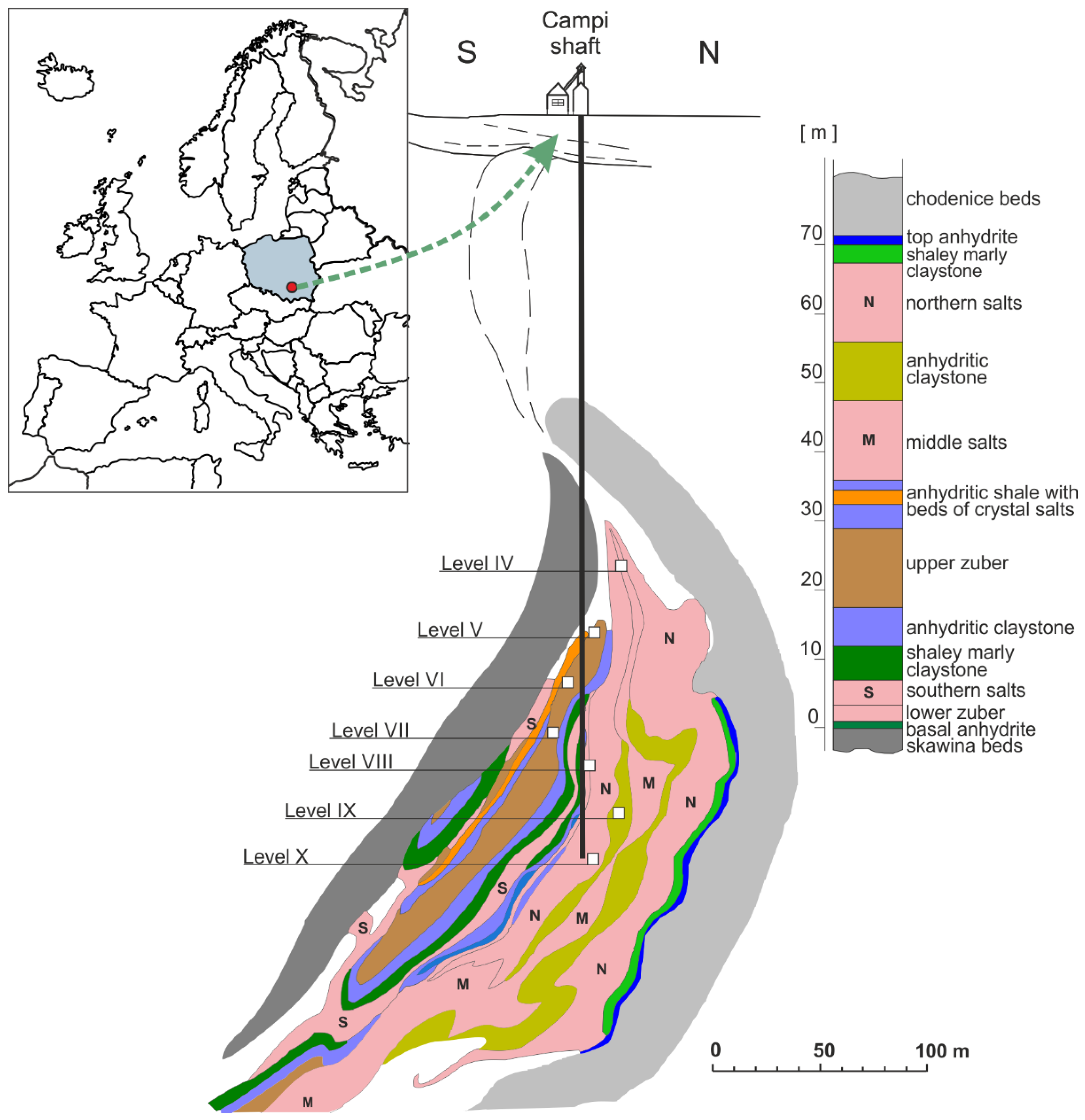
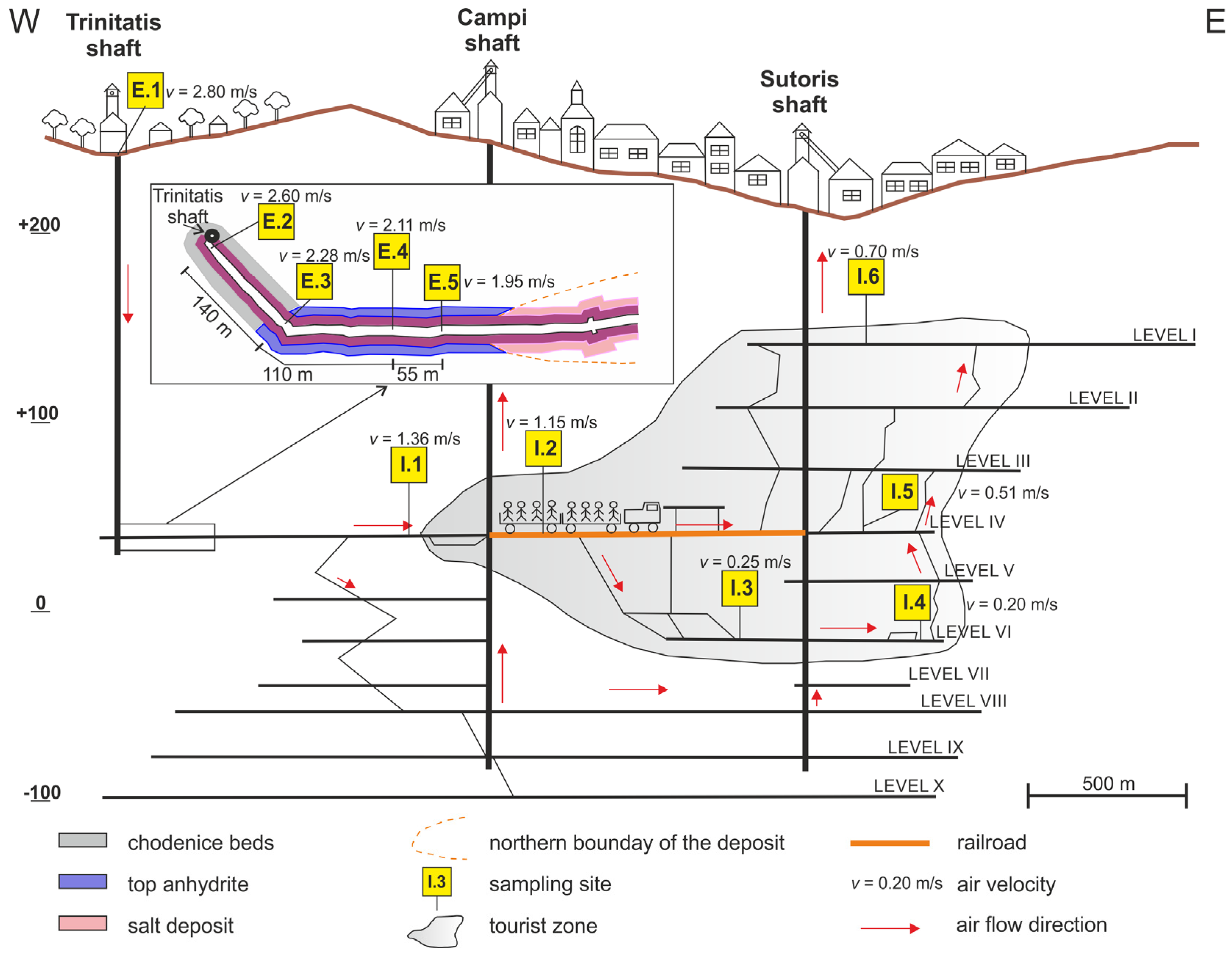
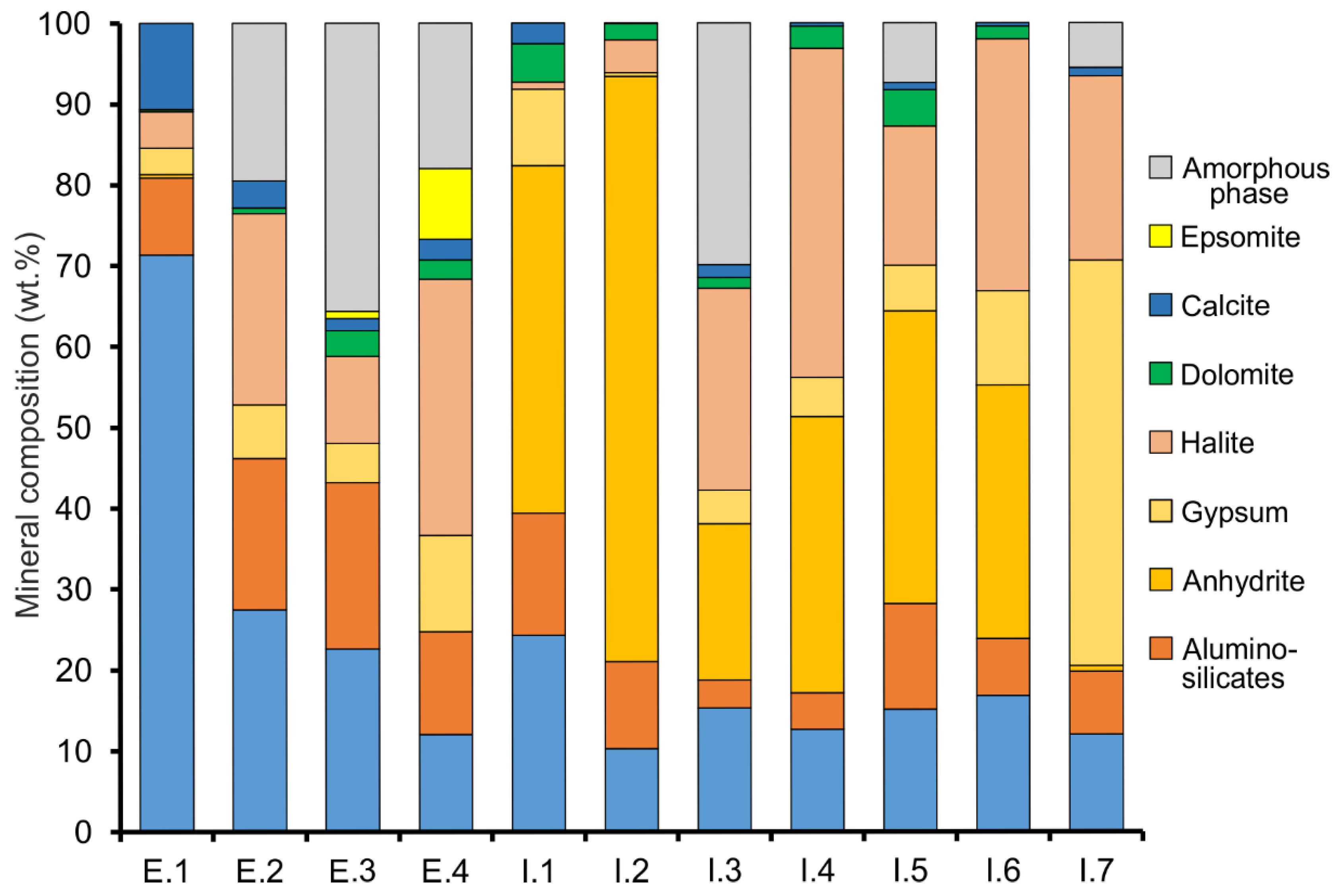
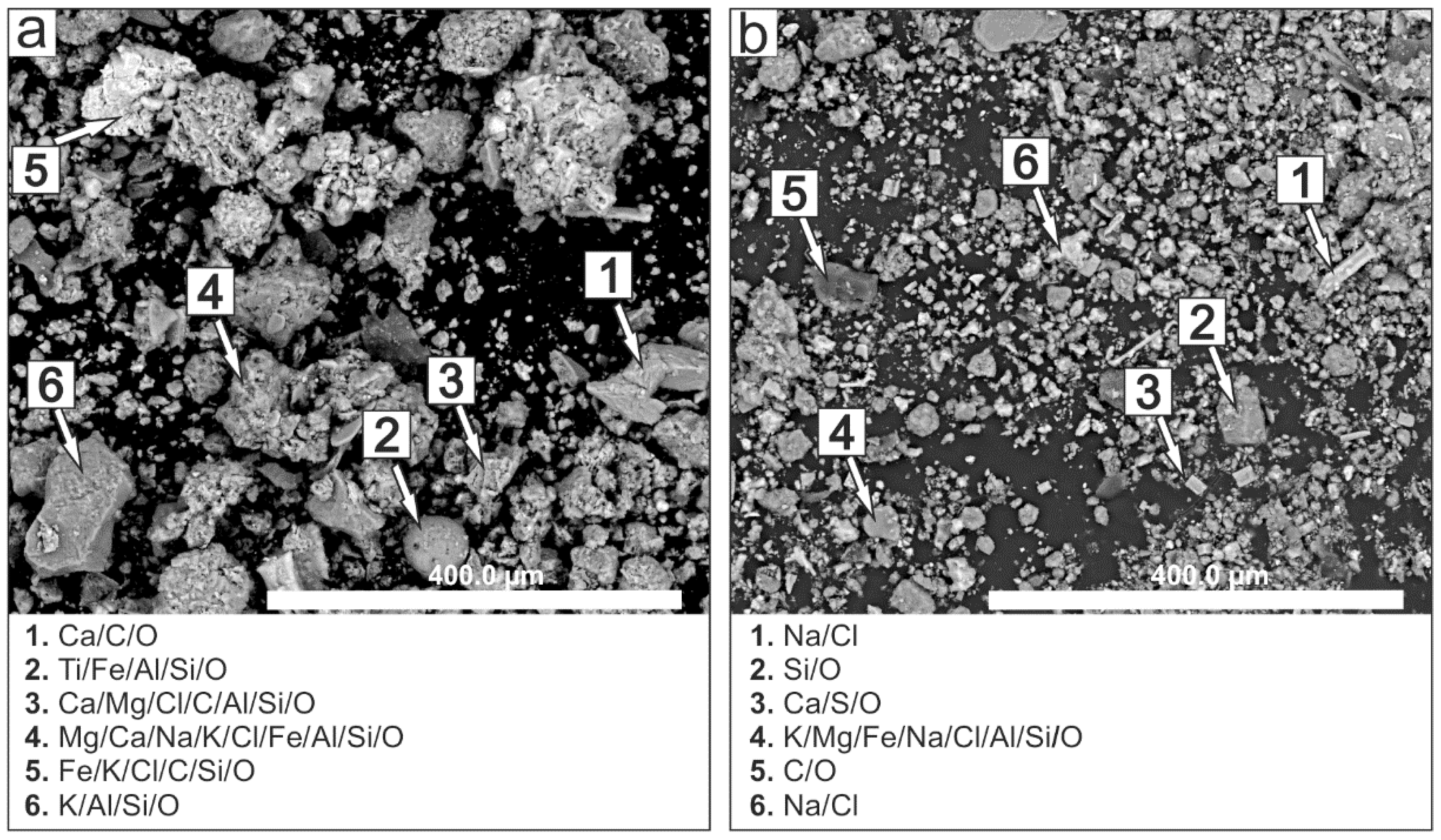
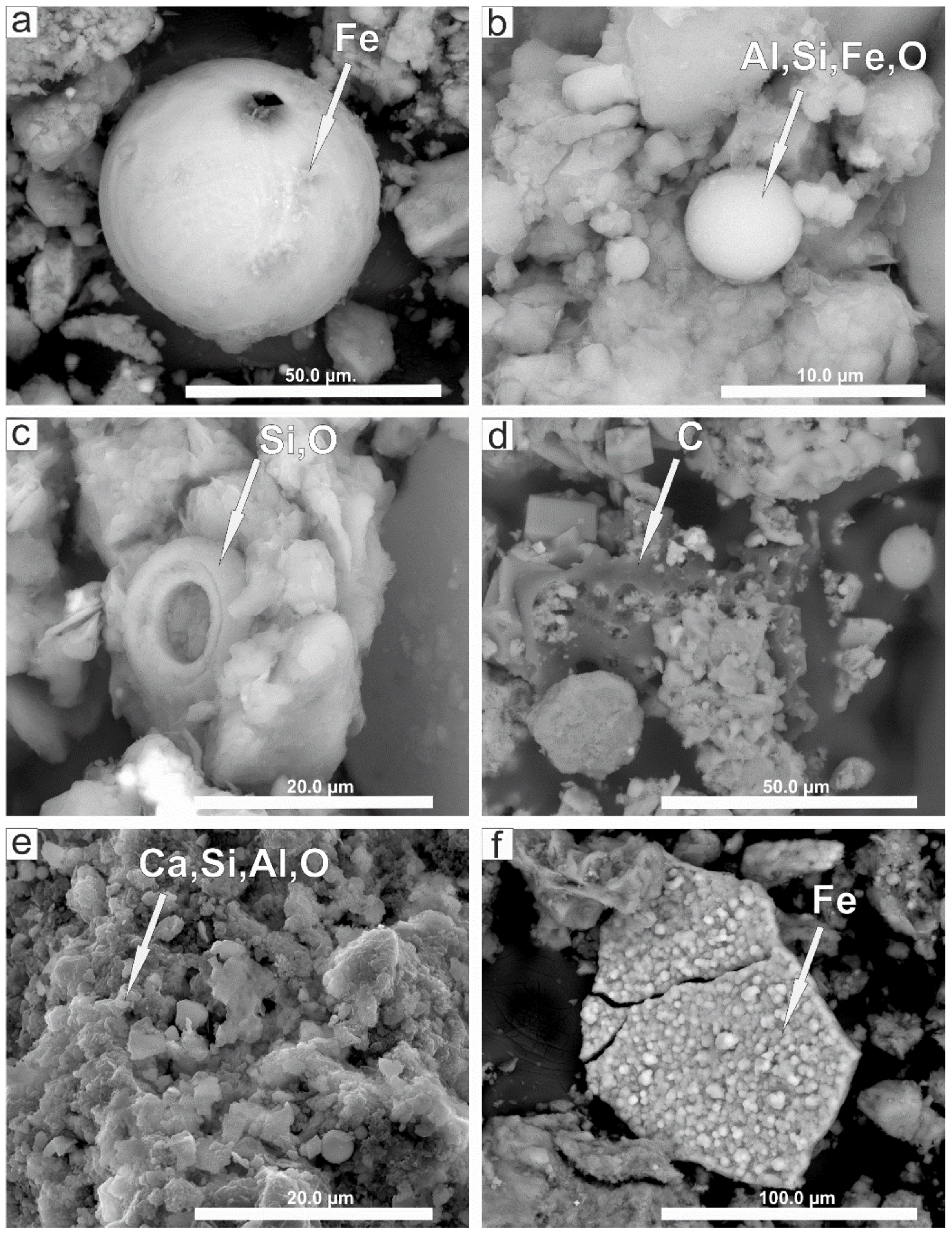
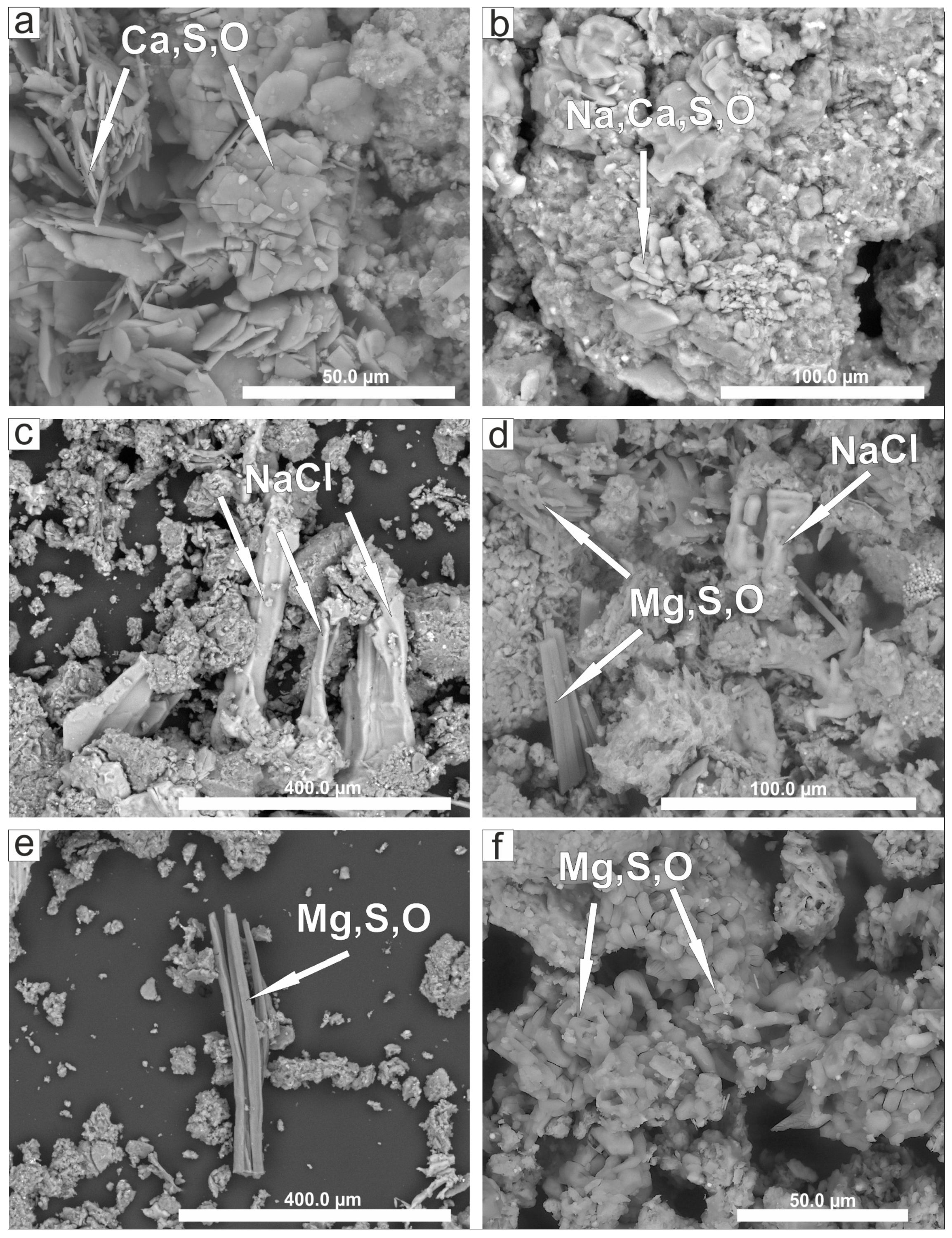
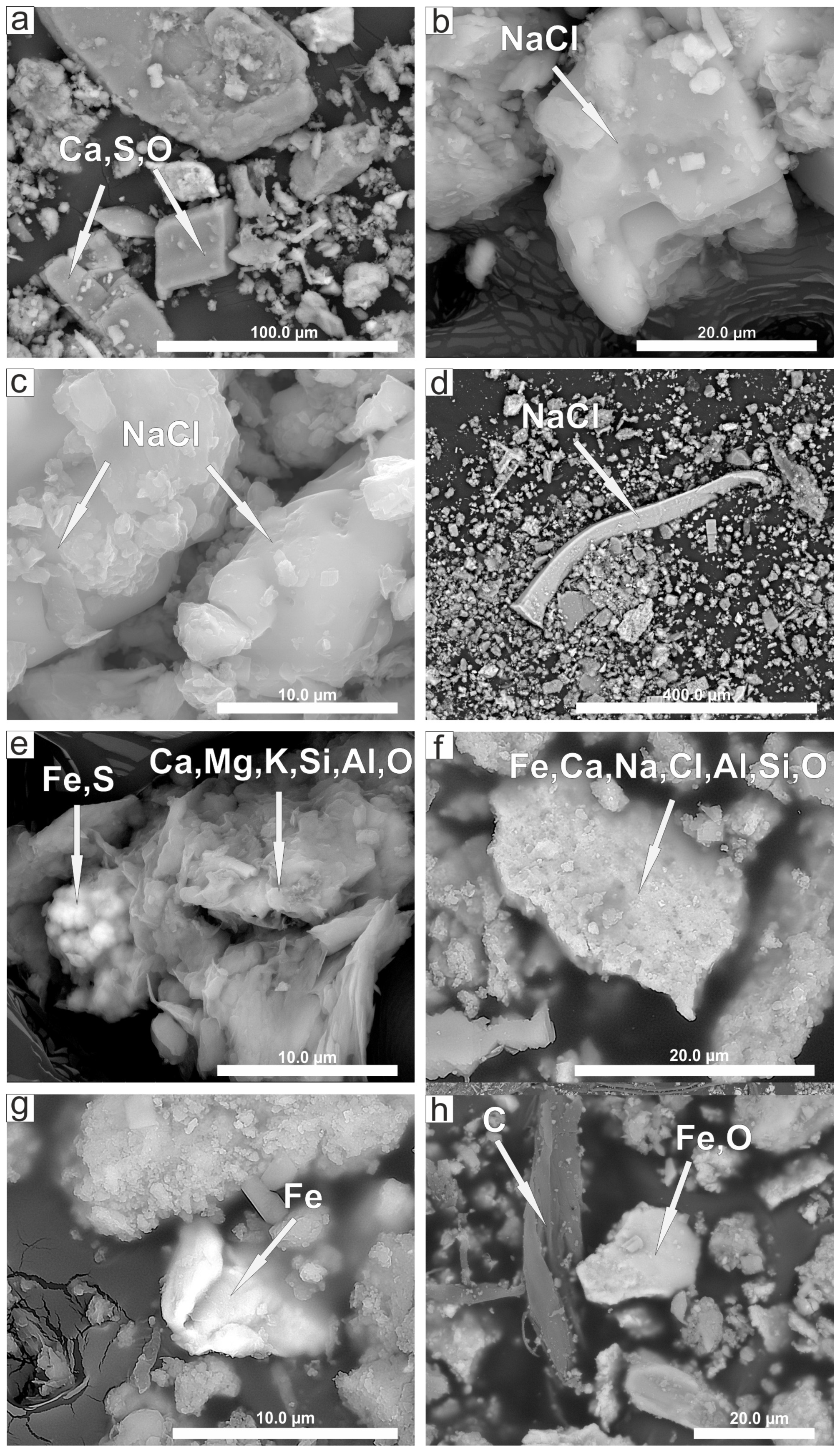
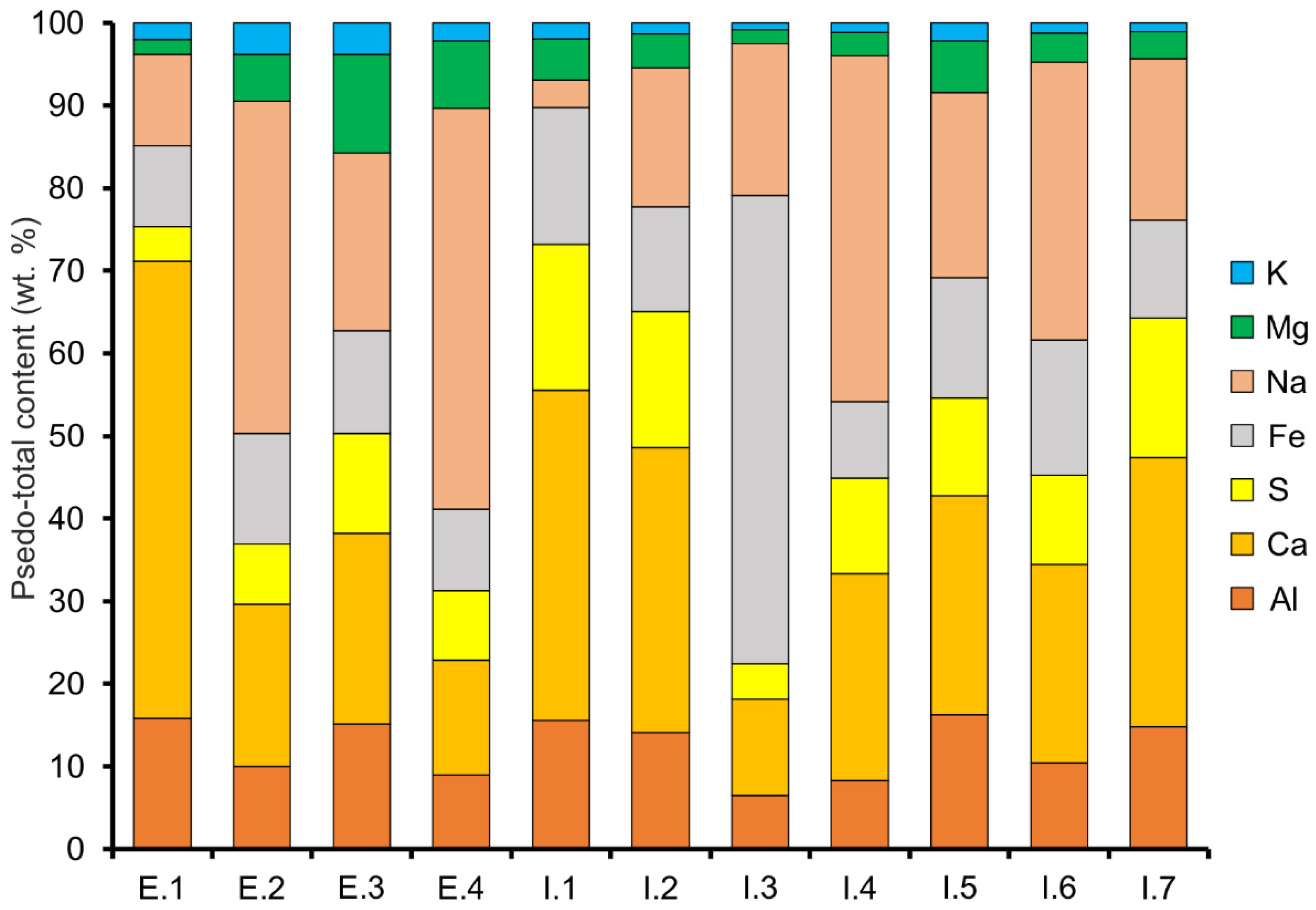
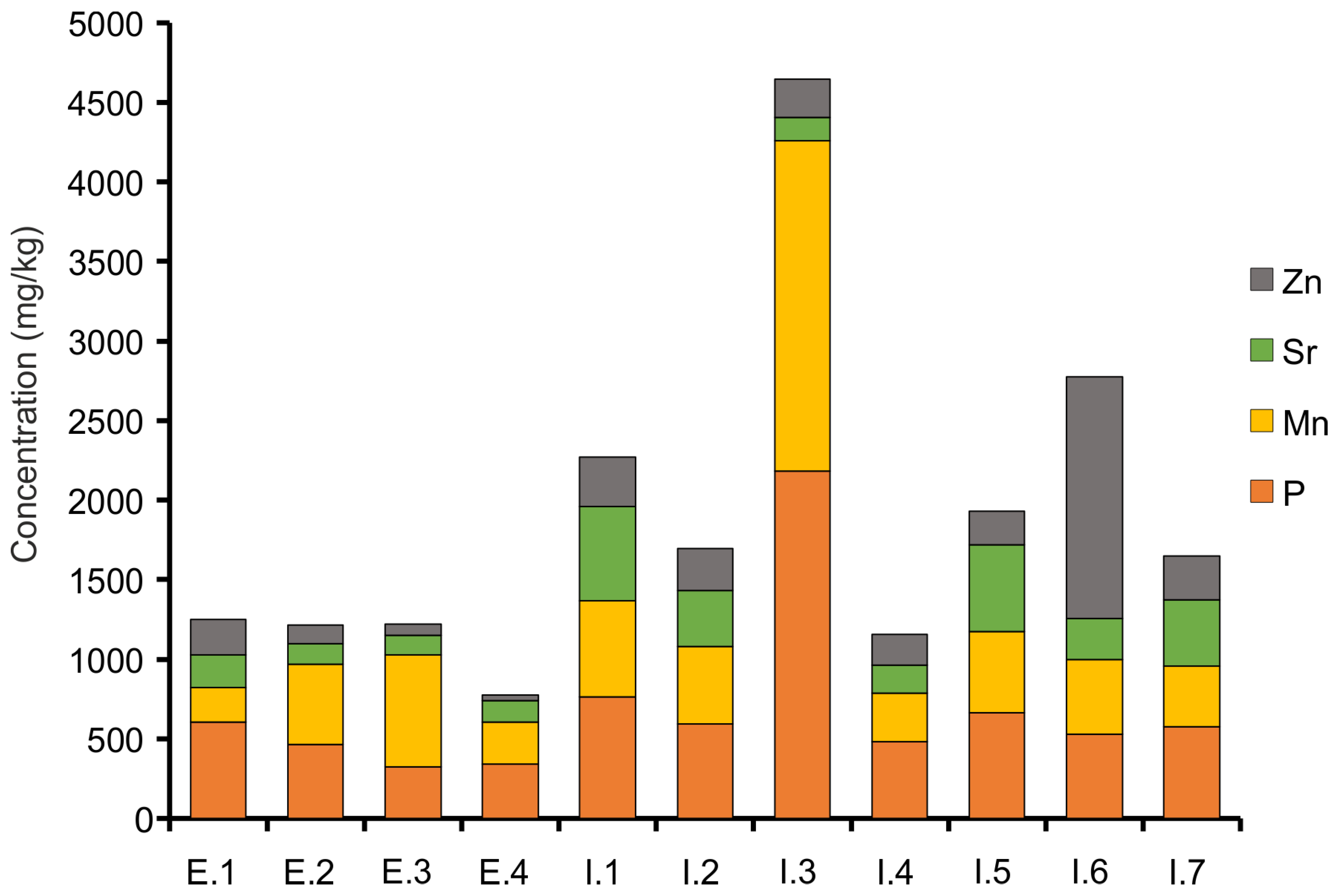
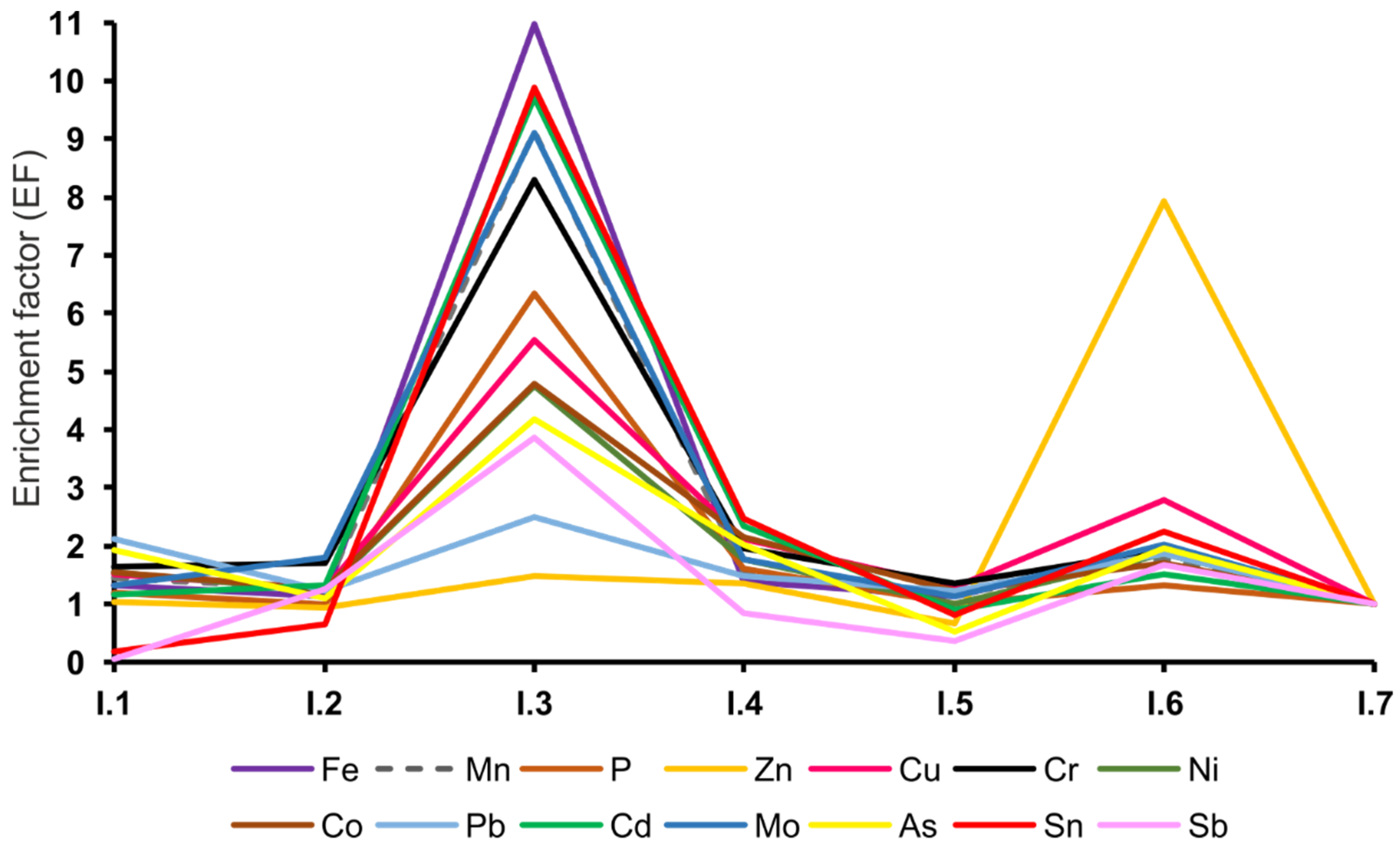
| Element | LOQ | E.1 | E.2 | E.3 | E.4 | I.1 | I.2 | I.3 | I.4 | I.5 | I.6 | I.7 |
|---|---|---|---|---|---|---|---|---|---|---|---|---|
| g/kg | ||||||||||||
| Al | 0.00001 | 19.3 | 18.5 | 27.5 | 14.8 | 34.1 | 32.1 | 18.5 | 15.9 | 35.4 | 21.6 | 31.0 |
| mg/kg | ||||||||||||
| Ti | 0.02 | 162.3 | 28.5 | 16.1 | 6.9 | 24.4 | 80.3 | 57.7 | 22.2 | 50.9 | 25.2 | 37.9 |
| As | 0.001 | 7.1 | 6.7 | 10.0 | 5.2 | 11.0 | 4.5 | 9.9 | 4.2 | 2.4 | 5.4 | 4.0 |
| B | 0.01 | 5.3 | 1.6 | 1.5 | bdl | 1.2 | 2.8 | 1.1 | bdl | 4.2 | 8.5 | 6.5 |
| Ba | 0.01 | 60.0 | 45.5 | 74.1 | 31.4 | 185.0 | 64.6 | 74.6 | 45.6 | 56.5 | 48.1 | 95.9 |
| Cd | 0.0003 | 2.1 | 1.9 | 3.2 | 1.6 | bdl | 2.9 | 12.5 | 2.6 | 2.2 | 2.3 | 2.2 |
| Co | 0.0002 | 6.3 | 6.6 | 10.2 | 4.5 | 31.4 | 6.8 | 15.0 | 5.8 | 7.4 | 6.3 | 5.2 |
| Cr | 0.01 | 21.0 | 20.1 | 20.1 | 14.3 | 40.1 | 39.1 | 109.8 | 22.5 | 34.0 | 29.6 | 22.2 |
| Cu | 0.005 | 36.6 | 44.6 | 38.1 | 18.8 | 81.9 | 63.6 | 161.9 | 53.0 | 72.3 | 95.5 | 49.0 |
| Li | 0.005 | 14.8 | 76.6 | 94.2 | 58.1 | 32.2 | 25.6 | 12.6 | 14.5 | 31.1 | 22.4 | 16.8 |
| Mo | 0.0003 | 2.4 | 2.2 | 1.5 | 1.0 | 3.0 | 3.8 | 11.1 | 1.9 | 2.6 | 2.9 | 2.0 |
| Ni | 0.05 | 11.4 | 26.3 | 37.9 | 18.23 | 39.7 | 29.8 | 65.9 | 21.3 | 26.6 | 30.2 | 23.2 |
| Pb | 0.0001 | 14.8 | 23.4 | 14.6 | 7.2 | 32.9 | 12.4 | 14.6 | 7.4 | 13.6 | 12.7 | 9.8 |
| Rb | 0.0003 | 87.1 | 34.4 | 58.2 | 26.1 | 51.4 | 42.5 | 61.8 | 47.9 | 37.6 | 37.3 | 32.1 |
| V | 0.001 | 26.3 | 14.6 | 21.1 | 12.1 | 24.2 | 22.2 | 15.1 | 11.5 | 25.9 | 16.0 | 16.1 |
| Zr | 0.002 | 7.3 | 5.6 | 6.5 | 2.7 | 7.7 | 9.7 | 6.2 | 3.9 | 5.7 | 4.3 | 4.8 |
| µg/kg | ||||||||||||
| Ag | 1.0 | 575.2 | 687.2 | 1387.4 | 994.5 | 910.8 | 1167.4 | 2813.1 | 833.3 | 2836.7 | 953.4 | 1281.4 |
| Be | 0.5 | 400.3 | 372.4 | 649.7 | 269.7 | 604.3 | 597.7 | 325.3 | 285.3 | 577.4 | 334.8 | 382.1 |
| Se | 10 | 455.0 | 1010.9 | 1721.3 | 0.0 | 1234.7 | 761.3 | 0.0 | 0.0 | 0.0 | 572.8 | 0.0 |
| Sn | 1 | 548.4 | 1216.3 | 1913.8 | 430.2 | 279.3 | 950.0 | 8253.6 | 1788.6 | 1305.1 | 2200.0 | 1400.0 |
| Sb | 0.2 | 277.3 | 410.5 | 30.1 | 2.5 | 55.3 | 1228.8 | 2202.8 | 419.4 | 399.3 | 1115.5 | 956.5 |
| Tl | 20.0 | 314.0 | 167.1 | 227.1 | 178.6 | 439.8 | 187.9 | 120.6 | 125.8 | 201.2 | 138.1 | 196.9 |
| Hg | 0.1 | 3.6 | 5.2 | 29.6 | 6.8 | 6.3 | 5.6 | 5.2 | 3.6 | 5.5 | 3.1 | 5.3 |
| U | 0.1 | 2.6 | 599.8 | 1126.0 | 594.5 | 6.3 | 5.6 | 5.2 | 3.6 | 5.5 | 3.1 | 5.3 |
| W | 0.3 | bdl | bdl | bdl | bdl | bdl | bdl | 551.6 | bdl | bdl | bdl | bdl |
Publisher’s Note: MDPI stays neutral with regard to jurisdictional claims in published maps and institutional affiliations. |
© 2021 by the authors. Licensee MDPI, Basel, Switzerland. This article is an open access article distributed under the terms and conditions of the Creative Commons Attribution (CC BY) license (https://creativecommons.org/licenses/by/4.0/).
Share and Cite
Puławska, A.; Manecki, M.; Flasza, M. Mineralogical and Chemical Tracing of Dust Variation in an Underground Historic Salt Mine. Minerals 2021, 11, 686. https://doi.org/10.3390/min11070686
Puławska A, Manecki M, Flasza M. Mineralogical and Chemical Tracing of Dust Variation in an Underground Historic Salt Mine. Minerals. 2021; 11(7):686. https://doi.org/10.3390/min11070686
Chicago/Turabian StylePuławska, Aleksandra, Maciej Manecki, and Michał Flasza. 2021. "Mineralogical and Chemical Tracing of Dust Variation in an Underground Historic Salt Mine" Minerals 11, no. 7: 686. https://doi.org/10.3390/min11070686
APA StylePuławska, A., Manecki, M., & Flasza, M. (2021). Mineralogical and Chemical Tracing of Dust Variation in an Underground Historic Salt Mine. Minerals, 11(7), 686. https://doi.org/10.3390/min11070686






